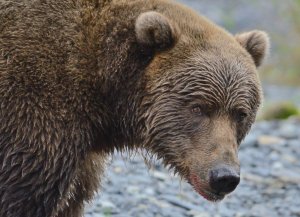Experts will tell you that the mating season for Kodiak bears occurs from mid-May to mid-July, but we have seen bears mate in April; and in fact, this year my husband spotted a boar and sow together on April 24th, and my brother-in-law saw two bears mating on April 21st. The peak of the mating season occurs in June.
Brown bears are considered serially monogamous. A female may stay with a male for several days or weeks, mating many times, and once he leaves, she will be pursued by her next suitor. Over the course of the mating season, she will have several sexual partners. Sometimes a male chases away a sow’s present mate, and then she will mate with the newcomer, or the two bears may fight, and she will mate with the victor.
Often when a boar first approaches a sow, she appears to be frightened and runs from him. The boar may then methodically pursue the sow at a measured pace, following the scent of her trail. At times, a boar seems to use little “common sense” when following the trail of a sow. We watched one male slowly follow the female’s scent, but when she doubled back and passed within sight of the boar; instead of moving toward her, he continued to follow her scent, until he too doubled back on her trail.
Once the boar catches up with the sow, she may refuse to let him breed with her for several days. As foreplay, they sometimes rub, cuff, or even bite each other. The breeding process may last forty-five minutes or longer, with the male taking breaks and sometimes falling asleep during the process.
Ovulation in bears is not spontaneous as it is in humans but is induced by mechanical stimulation by the male. The boar has a penis bone, or baculum, that stimulates the female to ovulate. The stimulation must last for quite some time to induce ovulation, so the mating session must be fairly long to be successful. Each ovulation produces only one egg, so bear cubs are fraternal and not identical, and cubs from the same litter may have different fathers.


